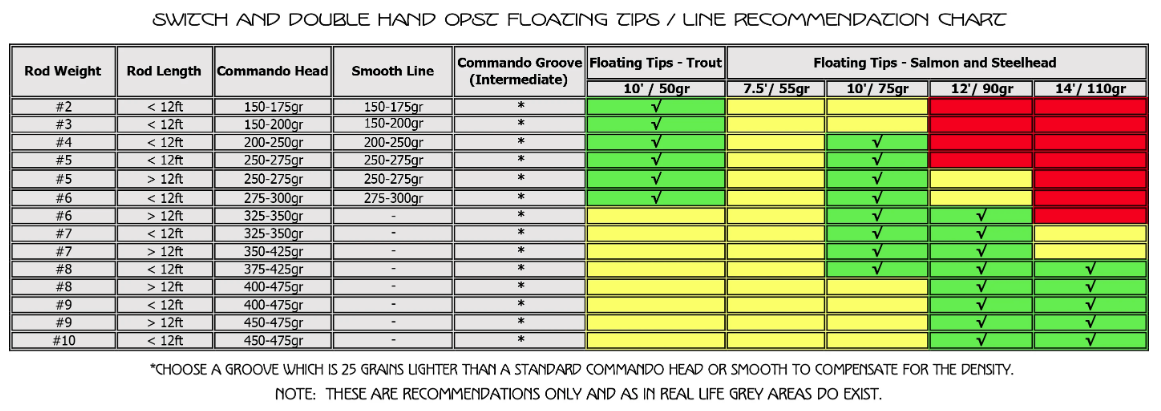
Fly lines – image by WISH
It can be confusing pairing fly lines and fly rods using Industry Standards of the American Fly Fishing Trade Association
By Skip Clement
Except for professional guides, fly shop owners, and dedicated fly fishers working on their umpteenth passport, the AFFTA grain weight charts – matching rod weight with grain weights can be misleading as Fox’s celebrity anchors speaking on how the world turns.
Still, it would be hard to blame AFFTA for the confusion because two things wreck the tables. One is the advent of very fast fly rods, which are good for all if ‘used’ properly and within keeping with skills – no matter your slow or fast preference [read on]. The other problem for AFFTA’s chart is fly line manufacturers using over 30-feet as their fly line load and under 30-feet to load a rod.
The head length/taper impacts how a line loads the rod
Today, a standard fly line could have a longer head, often somewhere in the 40-foot range. These are good all-around lines that perform smoothly, but the grain weight in the head is spread out over a large area. With its 47-foot head length, the RIO Gold series is an excellent example in this category.
A line made to load a rod faster will have a shorter, more aggressive head, often with additional weight built-in towards the very front – this helps load a rod quicker because there’s more available weight to cast with less line out. — Wolbugger
Fly line manufacturers have changed from traditional taper weights of using the standard – first 30-feet fly line
The universal measuring length for all fly lines has changed to vastly impacting heavily weighted ‘shooting heads.’ Thus, for example, OPST Commando Heads [see charts below], RIO’s Outbound Short lines, and others with similar ‘shooting head’ fly lines.
To make sense of it all, if you’re relatively new at fly fishing, isn’t easy because you have to make a concerted effort to choose the fly rod and a fly line or fly lines – and of course, a reel. BTW: Accomplishing that at a big box store or a Walmart approaches impossible.

The same fish, but not the same rods or fly lines. You’re never stuck.
The very best way to make the right choices for fly rods and fly lines is to make an appointment with a fly shop – tell them what you will be using the fly rod for, your experience, and budget
A quality fly shop will have fly rod demos on hand, reels, and fly lines for you to try out. A little more advanced angler will own at least one fly rod set up and, if not enjoying how it casts, should bring it to a fly shop via an appointment and get an evaluation. If advanced and having issues with your casting, have a fly fishing guide or offshore captain you’ve made an acquaintance analyze your casting. You might need a fly line adjustment with that new rod.
As we age
Getting long on the tooth usually means slower action fly rods work better, but there’s a way to keep fast rods as starters and not in Bull Pen. So I started giving away rods in the fast category that ended up in my Bull Pen – never getting a start. Then, I had to come to grips with giving up two rods in the high dollar range, and I hit pause, thankfully.
I had tiptoed into the geriatric age – manifesting itself in my no longer casting my favorite 2011 Sage ONE well on its bi-annual away games in Alaska
Several years ago at a fly fishing show in Orlando, I got Simon Gawesworth to up-line one weight, then two weights of a fast Sage rod [cannot recall model], and I got what I came for – changing line weights to meet my skill level. My still favorite ONE nine gets starting roles for me each season in the salt or freshwater.
Fast action fly rods require short, aggressive heads. As a result, they create efficient rod loading and make casting fun, smooth, and two-handed an all-day thing without physical exhaustion.
These short head fly lines require minimal line out the end of the rod tip; anglers will discover that lines that load fast are challenging to be accurate with at short distances, but that now being well-known is addressed as such with major fly line producers like Rio Products.
The slow action fly rods can be paired with these short, heavy fly lines with the opposite over overlining true, allowing the action to dissipate enough to make those perfect presentations.
Concluding:
If your favorite fly rod does not age or morph, but you do. Think about adding a few spools to your armory with lines for all occasions, and keep that expensive fly rod in the lineup.






